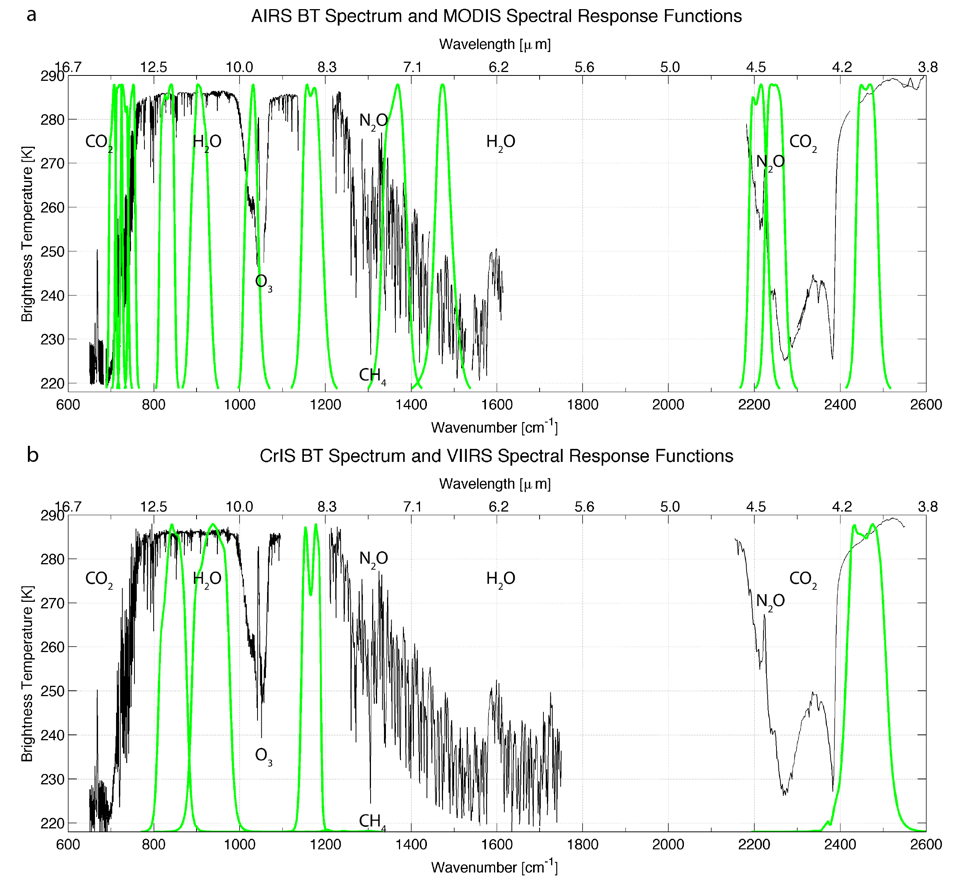Background
A primary goal of the NASA Suomi-NPP program is to provide continuity in the Earth science products with those obtained from the Earth Observing System (EOS) Aqua and Terra platforms. The ability to achieve continuity is more straightforward when the information content of the satellite sensors does not change radically, i.e., the radiance measurements are continuous in wavelength. For example, when improvements are made in geostationary imagers, more channels are added to the already existing and historical set of measurements. If measurements are taken for at least the historical set of channels, then the task of building continuous products is straightforward.
The path for polar-orbiting imagers is not as straightforward. The Advanced Very High Resolution Radiometer (AVHRR) has been the imager for the NOAA polar-orbiting platforms since 1978. There have been modifications to the AVHRR over time, e.g., with the addition of a 12-µm channel beginning with the AVHRR-2 series and the addition of a 1.6-µm channel beginning with the AVHRR-3 series.
The MODerate resolution Imaging Spectroradiometer (MODIS) sensors on the Terra and Aqua platforms provide measurements in the infrared (IR) water vapor (at 6.7 µm) and carbon dioxide (4.3- and 15-µm) sensitive bands, as shown in Fig. 1a. These so-called sounding bands are useful because they provide a sense of the vertical structure in an atmospheric column. This is especially important when inferring properties for optically thin clouds such as cirrus (Menzel et al. 2008; Baum et al. 2012). With a better sense of the vertical distribution of the clouds, the inferred cloud properties are more consistent daytime to nighttime, over mountain ranges, and in high latitude regions. Heidinger et al. (2010) employed an optimal estimation (OE) approach using IR bands to infer cloud top pressure. This study clearly showed how the use of even a single sounding band located at 13.3-µm supplementing the IR window bands improved the analysis of optically thin ice clouds over that from use of only IR window bands. Furthermore, the ability to discriminate between low-level and high-level clouds has been found to be critical for improving the determination of the cloud thermodynamic phase (Baum et al. 2012). The MODIS Collection 6 IR cloud phase software incorporated cloud emissivity ratios to improve high/low cloud discrimination, resulting in a much improved product.
The current polar-orbiting imager is the Visible Infrared Imaging Radiometer Suite (VIIRS). VIIRS has several major improvements to the earlier imagers, including pixel spatial resolution that remains essentially constant across the scan. One of the primary limitations for determining cloud properties with VIIRS is that it has only IR window bands, as shown in Fig. 1b. The information content provided by the VIIRS radiance measurements lies between the AVHRR and MODIS sensors. Without even a single IR carbon dioxide or water vapor sensitive band, the MODIS-like cloud top pressure/height and phase algorithms cannot be transitioned to VIIRS because of a fundamental loss of information. The lack of any sounding channels primarily impacts the inference of cloud properties including cloud-top height/pressure/temperature and IR thermodynamic phase. We developed an innovative solution to this problem by using VIIRS and CrIS data to construct high spatial resolution spectral bands for VIIRS in the CO2 (MODIS bands 24, 25 and 33-36), the O3 (MODIS band 30), and the H2O (MODIS bands 27 and 28) spectrally sensitive regions. The approach is described in Weisz et al. (2017) and also in our ATBD.
Our software for constructing IR radiance bands is mature and has been transitioned into Atmosphere SIPS (Science Investigator-led Processing System) operations. A benefit of our approach is that we can also construct new spectral band radiances for VIIRS that exclude strong trace gas absorption lines or fulfill other criteria, e.g., water vapor bands with narrower bandwidths. That is, we can construct radiances assuming either continuous or discrete spectral response functions. A further bonus from fusion is the mitigation of detector-to-detector radiometric differences that cause striping and product retrieval uncertainties.

Figure 1: (a) AIRS infrared brightness temperature spectrum (black) with main absorbers indicated, with the MODIS spectral response functions (SRFs; green) superimposed. (b) CrIS infrared brightness temperature spectrum with the VIIRS SRFs superimposed. The spectral response functions are scaled to fit the brightness temperature range. From Weisz et al. (2017).

